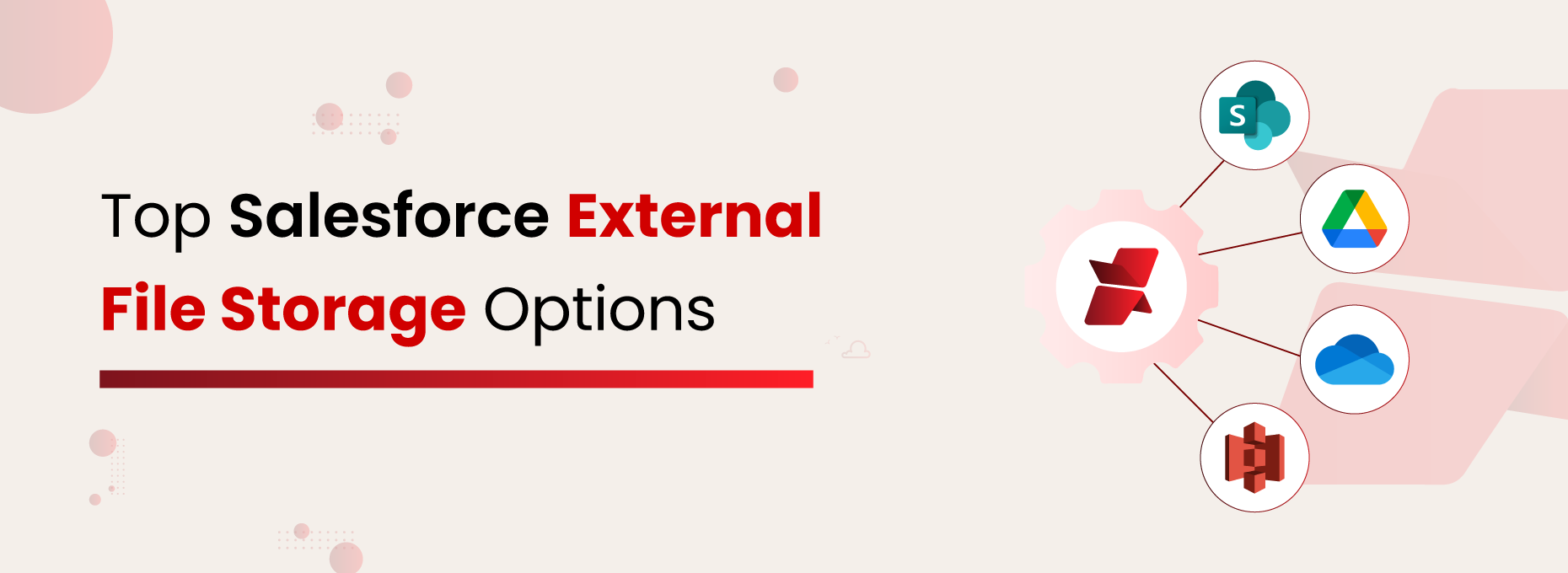As the digital load in your Salesforce ecosystem grows, optimizing file storage becomes not just important, but essential for efficiency and cost management. Moreover, many organizations must adhere to strict policies that govern the collection, storage, retention, and access of files to ensure security and compliance.
But is Salesforce storage flexible enough to handle all that daily file activity?
Unfortunately, it is not. Native Salesforce file storage options provide limited control over file organization, have restricted sharing capabilities, and struggle to scale with increasing file volumes. To make things tougher, the high Salesforce storage price means businesses end up paying premium costs to store growing volumes of data.
Integrating Salesforce with a dependable external storage solution can be a transformative step. And that’s exactly what XfilesPro is built for, with powerful features that support a wide range of external storage platforms to help you manage files more efficiently. The application empowers businesses to offload files to leading external storage platforms while staying fully connected to their CRM data.
In this blog, we’ll take you beyond the limitations of native file storage. You’ll discover the top Salesforce file storage options, understand why they’re essential for growing businesses, and learn how XfilesPro simplifies Salesforce document management.
Poornima G
Salesforce File Storage Limits
Simply put, Salesforce was built to manage customer relationships, not to store large volumes of files. However, as the platform’s user base grew, so did requests for more storage.
To keep up, Salesforce started offering extra storage, but it came with a cost. And let’s be honest, in today’s world, every extra convenience comes with a price tag.
Salesforce Storage Price
Salesforce provides limited file storage, typically 10 GB for the entire organization and 2 GB per user license. For small teams, paying $5 per month for each additional GB might be manageable. But scale that across multiple departments, regions, and years, and it quickly turns into a five- or six-figure expense.
Understanding the Hidden Cost of Salesforce File Storage
Plus, there’s more than just cost to consider:
File Management Becomes Inefficient
Native Salesforce features for file management fall short when it comes to uploading and retrieving files. The CRM also lacks advanced capabilities such as version control, folder structures, bulk upload options, intelligent search, and easy file sharing.
Without these, collaboration across departments feels clunky, and searching for the right file slows productivity
Compliance and Security Risks Increase
Salesforce’s native storage provides only basic protection, leaving gaps that regulated industries can’t ignore. Beyond the absence of audit trails, encryption, granular permissions, and retention policies, it also lacks advanced tools like real-time monitoring, automated compliance checks, data loss prevention (DLP) rules, and customizable access controls.
These limitations make it difficult to safeguard sensitive information, ensure accountability, and meet strict regulatory requirements.
Regulated industries like healthcare, finance, and government can’t afford these gaps.
That’s why so many organizations are now choosing external document storage for Salesforce. These platforms are purpose-built for document management and offer a wide range of features. They boost collaboration, enhance security, simplify file retrieval, ensure compliance, and reduce Salesforce storage costs significantly.
Benefits of Using External Storage Options for Salesforce Files
External cloud storage allows users to overcome native Salesforce storage limits while unlocking end-to-end file management capabilities.
Let’s break down what external file storage platforms bring to the table, and why they’ve become the go-to solution for modern Salesforce users.
| Benefit | How It Helps Salesforce Users |
|---|---|
| Cost Optimization | Instead of paying Salesforce’s premium rates for every GB, external platforms like Amazon S3 or Google Drive reduce storage costs by up to 85%+ compared to native Salesforce storage. |
| Scalability | Through Salesforce external storage integration, platforms like SharePoint, Google Drive, and Amazon S3 scale effortlessly as your business grows. In fact, 45% of organizations are actively scaling up their cloud capabilities. |
| Centralized Access | Employees currently spend over 5 hours per week just searching for documents. With centralized Salesforce file management, employees find files faster, cut down wasted time, and boost productivity. |
| Advanced File Controls | External platforms bring smarter features like tagging, metadata, version history, and role-based permissions. |
| Compliance & Security | External storage offers stronger protections like encryption, access audits, and geo-redundant backups, essential for regulated industries. |
Common Ways to Integrate External File Storage to Salesforce
Salesforce external storage integration sounds simple, but not all methods are created equal. Here’s a breakdown of popular approaches and the limitations that can hold your business back:
Native Connectors
While these are easy to install, native connectors often come with limited customization and may not scale well for complex file management. Many only support basic upload/download functionality and lack advanced file control, automation, or multi-storage flexibility.
Direct API Integrations
APIs offer flexibility, but they require skilled developers and ongoing maintenance. Even a small API change from the storage vendor can break the integration, leading to downtime. Plus, building and maintaining security compliance for API-based integrations can be expensive and time-consuming.
Middleware Platforms (e.g., MuleSoft, Zapier, Workato)
Middleware helps you avoid heavy coding, but these platforms often add latency, cost, and complexity. They work best for simple workflows, not robust file storage use cases. You may also hit platform limits or run into vendor-specific compatibility issues.
AppExchange Solutions
AppExchange apps are popular because they’re easy to install, come pre-tested, and offer plug-and-play functionality for Salesforce users. Many businesses opt for these solutions to quickly connect Salesforce with external storage platforms like SharePoint, Google Drive, or Dropbox, without writing code.
XfilesPro, The Most Trusted, Most Reviewed AppExchange Solution for Salesforce Storage.
Top 4 Salesforce File Storage Options
External file storage solutions are essential for businesses scaling beyond Salesforce’s native file storage limits. They improve performance, reduce costs, and strengthen document control. XfilesPro helps Salesforce users make the most of these platforms by offering seamless integration and advanced file management capabilities without needing extra middleware.

Here’s how XfilesPro supports the top storage options:
Microsoft SharePoint
Google Drive
Amazon S3
OneDrive for Business
OneDrive offers secure cloud storage with deep integration into Microsoft 365. Salesforce-OneDrive integration enables seamless file offloading, folder-level access, version control, real-time syncing, and automatic file organization across user-specific or shared directories.
Apart from integration to make document management easier, XfilesPro gives additional features such as:
- Bulk File Transfer– Quickly move multiple files from Salesforce file storage to external storage to free up space.
- Smart Folders– Automatically create folders based on record type to maintain organization.
- Real-Time Sync – Changes are instantly reflected on both sides, making updates seamless.
- View in Salesforce– Access files from Salesforce, even if they are stored externally.
Use Case
A leading heavy equipment manufacturer faced a major challenge, managing thousands of files generated daily by internal teams and dealers. With documents scattered across storage systems, locating the right file became time-consuming. Lack of folder synchronization led to outdated versions, and access control was a constant struggle. With multiple users needing different levels of access, ensuring security and efficiency was difficult without a structured system.
They needed a way to streamline file organization, keep documents updated, and control access based on roles, all without disrupting daily operations. That’s when they looked for a smarter, more scalable document management solution.
That’s where XfilesPro’s Salesforce storage solution stepped in.
How a Manufacturer Transformed File Handling with XfilesPro
Conclusion
As businesses grow, the volume of daily file activity increases, and Salesforce storage can’t keep up. It’s limited, expensive, and not built for managing large amounts of files. That’s where external file storage platforms come in, offering better scalability, improved compliance, and cost savings.
With XfilesPro, you don’t just move files; you gain smarter organization, real-time syncing, enhanced collaboration, and full control over who can access your documents. Whether you use SharePoint, Google Drive, Amazon S3, or OneDrive, XfilesPro seamlessly connects your CRM to the storage solution your business needs.



